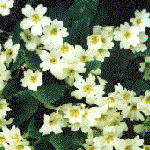 |
PRIMULACEAE - The Primrose Family
There are about 1000 members of this family, found in the temperate areas of the world, mainly in the northern hemisphere. They are mostly grown for ornament, and include the familiar Primrose and Cyclamen. They are all perennial or annual herbs, not trees or shrubs. |
Characteristics of this Plant Family:
Leaves, Stem & Roots ~ Most members of this family have some sort of storage organ to enable them to overwinter. This may be obviously enlarged, as in the Cyclamen tuber (corm), or just thickened roots with a resting bud, as in the many species of Primula.
The leaves are opposite or alternate, or form a rosette at the base of the stem, and are usually undivided. The leaves and stem may be hairy. The calxy is formed of five parts joined into a tube which remains after the flower dies, and inside which the seed pod develops.
Flowers ~ The flowers have five petals, joined into a tube at the base, and sometimes the ends are turned back. They are often on long leafless stalks, either singly or in groups. There are five stamens joined to the flower tube opposite the petals. In the genus Primula, there are two distinct arrangements of the style and stamens: Pin-eyed flowers are those in which the style is longer than the stamens and you can see the round stigma like a pin in the mouth of the flower tube, and Thrum-eyed, in which the stamens (the thrums) are longer and are visible at the mouth of the flower tube.
Seeds ~ The seed pod forms inside the calyx and is composed of five parts joined into a single chamber. There are usually many small seeds.
Members of this Family usually have:
Winter storage organs
Five petals joined in a tube
Five stamens joined to the tube opposite the petals
Calyx of five parts joined in a tube
Undivided leaves
Seed pod with one chamber forming inside the calyx
and are annuals or perennials, but not trees or shrubs